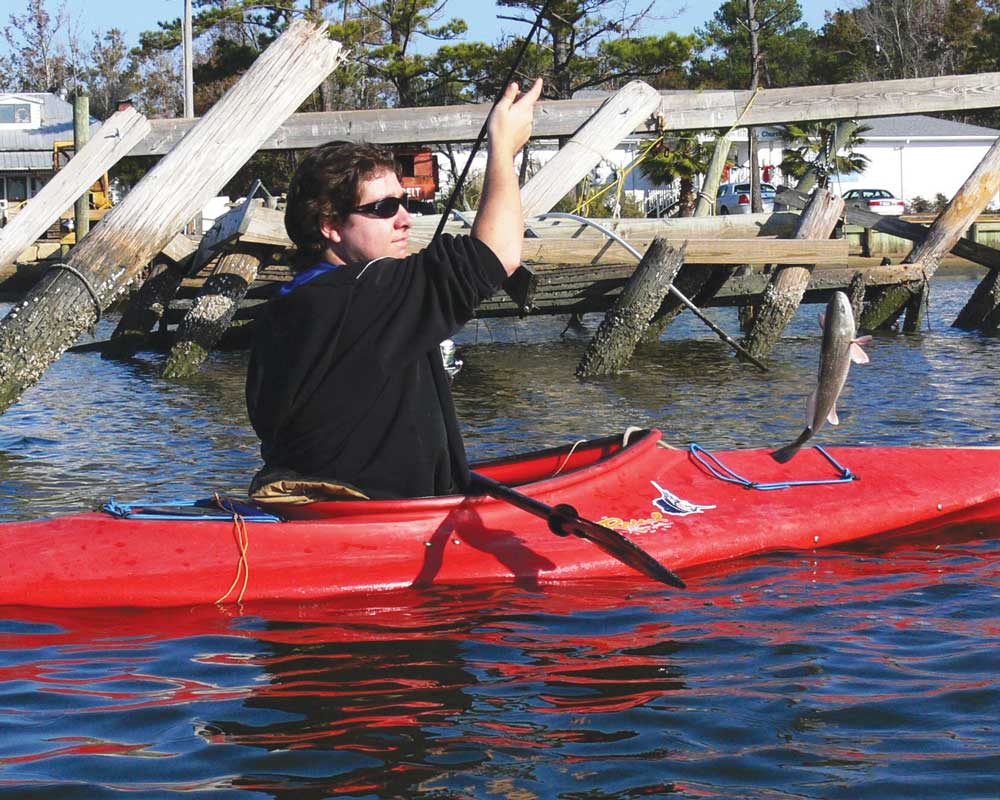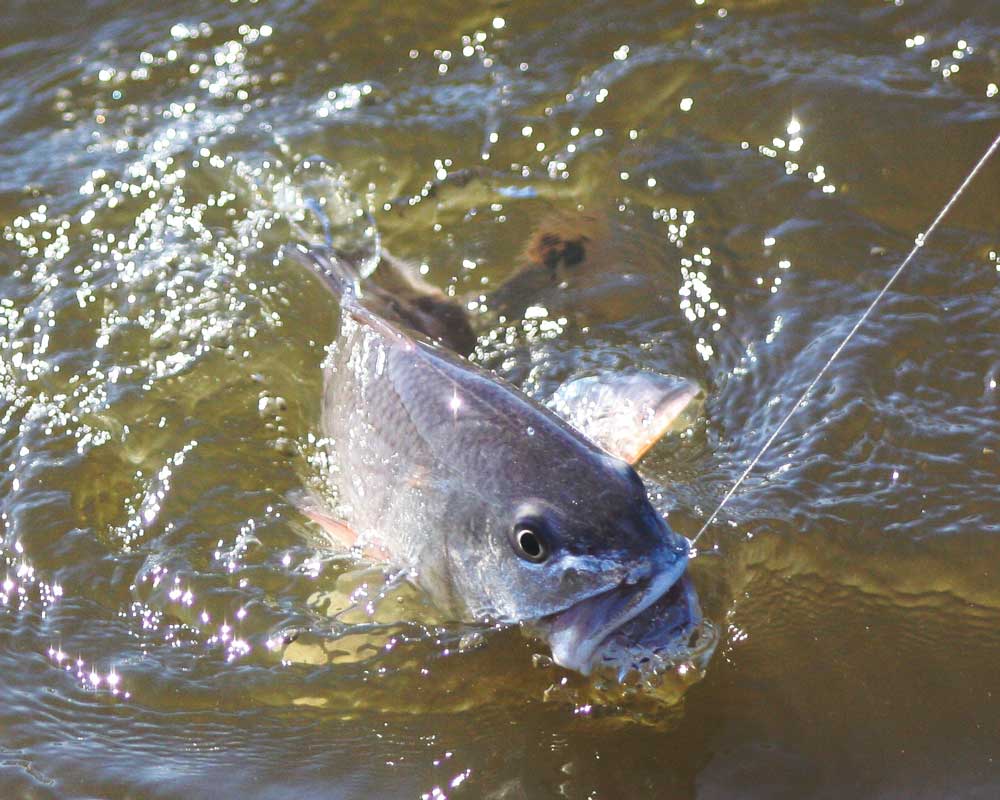Do bears sleep in the woods? Sure they do, and bull redfish can be found in the woods, too. Although, we hope it’s not in the same woods as bears.
My line sawed against the barnacle-covered wooden piling. A strong bull redfish pulled line from my reel, and as I knew it would do, the line finally gave a soft “pop” sound, and this particular fight was over. I didn’t really mind, though, because I had managed to hook and catch several copper-colored battlers earlier, and I knew I could hook even more redfish.
You see, I was fishing the “woods” for reds. I have found that redfish and wooden structure in the water are a natural combination.
What Kind of Wood?
It doesn’t take long for an angler on the Alabama coast to realize that our inshore waters are slap-full of wood. Everything from new docks to old docks to dead docks to trees and roots of long-dead trees can be found everywhere in the Mobile Bay system.
I have not found redfish to be very picky when it comes to wood in the water. As long as the wood is in the vicinity of deeper water, redfish will be near to the wood at times.
It’s not hard to figure out why wood in the water is such a great attraction for reds. The wood provides shelter for the redfish. More importantly, it provides shelter for the many kinds of smaller creatures that reds consider delectable. The “woods” are prime real estate for the redfish clan, and they are almost always close to home.
Old storm-killed wooden dock pilings provide a haven for reds. Even if only one piling is visible in a certain location, there are usually other pilings close by that are either just under the surface or pushed flat onto the bottom by storms and currents.
The more pilings are in an area, the more likely they are to hold good numbers of reds.
Speaking of wood, some of the very finest I’ve fished for reds were old tree roots.
Water levels in the bay rise and fall over time. When they do, trees that once lived and thrived on the shoreline can no longer survive, so they perish and the upper parts of the trees are soon worn away.
But the underwater wood of the trunks and roots are still there, and these underwater wooden structures hold some of the best redfish to be found in Alabama.
New docks are generally not as good as long-established underwater wood, but it really doesn’t take too long for a dock and its wooden underwater structure to become a dining hall for bull redfish.

Photo by Ed Mashburn
Where is this Wood?
In Alabama coastal waters, it’s almost easier to ask, “Where is there not any underwater wood?” On both sides of Mobile Bay, there are naturally occurring stump fields that harbor huge schools of hungry reds.
In Magnolia River, Fish River and Bon Secour River, I have found several great shorelines of underwater wood. All have produced a lot of reds for me through the years. Between Fish River and Bon Secour River are some very reliable stump fields lying near the shoreline. These stumps do take a bit of slow-speed searching to locate.
On the western shore of the bay, probably the very best stump field for reds I have ever seen is hidden far up Grand Bay. But there are many other places on the Mobile side of the bay harboring old trees and stumps in the water for reds.
Any of the local rivers and bayous will have old docks and other ancient wooden structures that are worth a good search to determine if the reds are home. In fact, about halfway up Bon Secour River is a double line of old underwater pilings.
These pilings are all that is left of an old causeway from many years ago that provided car and wagon access to parts of the area otherwise unreachable except by boat. The old causeway is long gone, but the pilings are still there, and the redfish love to live around the old pilings.
Farther up the Eastern Shore, the Daphne Pilings are locally famous for producing redfish. These pilings are easily seen and accessed from the park at Daphne. Kayaks and other small craft can quickly be in some prime redfish wood.
North of Interstate 10, anglers can find great redfish wood on any of the five rivers that empty into Mobile Bay. Just in the past month, I have located a prime field of old pilings up north of the Causeway just a bit, and I’ve been catching a lot of reds from these old underwater pilings.
These Blakely River pilings have it all: Thick wooden structure in shallower water, a sharp drop-off to 15 feet and more, and a good current from both tides plus the current of the river. When we locate structure that has all of these features, it’s a sure bet that reds will be there.
“Of course, reds always bite best when the water is moving.”
Of course, any of the docks that are still in active use and that have above-water structure intact are easier to find. Some of them always hold reds. It’s just that everyone who fishes a particular area will work these easy-to-see spots. Therefore, they receive a lot of fishing pressure. The newer docks and other structures are still worth the effort to fish.
My buddy, Robert Dobson of Foley, Ala., has forgotten more about fishing the Mobile Bay system than I’ll ever know. He has some advice for us when we go looking for reds in the wood.
“In rivers, the best redfish water is on the outside bends where the water is deeper,” he says. “Fish River has some of the best red fishing to be found on the Eastern Shore. These Fish River reds will almost always be found around wood in the water. Any outside bend in Fish River will have reds.”
Dobson adds, “Of course, reds always bite best when the water is moving.” If we find wood and current, we are very likely to find redfish.
How Do We Fish the Wood?
I have fished with Robert Dobson several times, and I have seen him fish the wood for reds a lot. He has caught some very nice redfish by fishing the wood in various places.
“When I’m fishing wood for reds, I’ll start with a crankbait,” he says. “I prefer a Splatterback Bandit-200 Series. This crankbait has a medium bill, which puts it about six feet deep. I like to fish reds on the wood fairly deep.”
A bit of advice from Dobson for those of us who want to catch reds on the wood structure has to do with getting close to the wood. “I try to bump the wood with the plug. Whether I’m fishing stumps or dock pilings, I want that crankbait to actually make contact with the wood. You learn the feel of the lure in the water as it moves back to you.
If you stop the lure as soon as it snags structure on the bottom, the plug will usually float free. Even when the plug hangs up and has to be broken off, a lot of times it will float up out of the wood.”
Of course, none of us like to lose lures, but if we’re not getting hung up occasionally while fishing the wood for reds, we’re not fishing in the right place or in the right way. If we’re in the wood after reds, losing a lure now and then is part of the process.
Dobson also likes to throw spinner baits for reds in the wood. “I like to fish spinnerbaits the same way I fish crankbaits,” he adds. “I fish them medium-slow and fairly deep.”
I watched Dobson slow retrieving a spinnerbait through a thick stump field one day on the Eastern Shore of Mobile Bay. He caught some very nice slot reds and one fine over-slot size red by bumping his spinnerbait against stumps.
Fishing wood with live bait is always a possibility. But again, we should expect to donate some tackle when big reds take us back into the woods and get us lost. Live shrimp and fiddler crabs take a lot of wood-oriented reds, but sometimes I have found reds in the wood that would only eat bull minnows.
We need to be prepared to offer the wood-reds what they want if we want to catch them on live bait.

Photo by Ed Mashburn
So, How Can We Find the Good Wood?
It’s not hard to locate docks and above-water pilings. All we have to do with these visible wooden structures is fish them and see which ones are better for holding redfish.
However, much of the best bull redfish wood is not usually visible above the water. So how do we find this hidden stuff?
There are a couple of ways that I have found good bull redfish wood that was underwater. The first way is by running into the stumps or old dock pilings with the lower unit of my motor. This is an effective way to find where the wood is, but it’s not the way I recommend.
The way I like to locate wood that is usually underwater is by going out in my boat during winter when a strong north wind has blown the water out of Mobile Bay, which makes the water levels of the entire bay system very low. Then, I look around. I have found several very good and productive stump and piling fields when they were exposed by low winter water level conditions.
Of course, you can always ask other anglers where their favorite redfish wood is, but don’t expect a dependable answer. When we anglers find a good patch of redfish wood, we are not always eager to share it with others.
So back to our original question: “Do wild bears sleep in the woods?” They sure do, and lots of bull redfish can be found in the wood, too. All we have to do is find them, hook them, and hold on for the fight.
